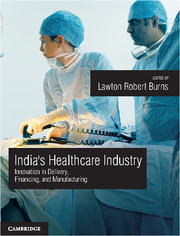Book contents
- Frontmatter
- Contents
- List of Figures
- Preface
- Acknowledgments
- SECTION I Introduction: Lenses and Frameworks for Analyzing India's Healthcare System
- SECTION II Providers: Delivery of Healthcare Services
- SECTION III Payers: Financing of Healthcare Services
- SECTION IV Producers: Manufacturers of Healthcare Technology
- 13 The Indian Pharmaceutical Sector: The Journey from Process Innovation to Product Innovation
- 14 India's Biotechnology Sector
- 15 The Medical Device Sector in India
- 16 Balancing Access and Innovation in Developing Countries
- Contributors
- Index
14 - India's Biotechnology Sector
Published online by Cambridge University Press: 05 June 2014
- Frontmatter
- Contents
- List of Figures
- Preface
- Acknowledgments
- SECTION I Introduction: Lenses and Frameworks for Analyzing India's Healthcare System
- SECTION II Providers: Delivery of Healthcare Services
- SECTION III Payers: Financing of Healthcare Services
- SECTION IV Producers: Manufacturers of Healthcare Technology
- 13 The Indian Pharmaceutical Sector: The Journey from Process Innovation to Product Innovation
- 14 India's Biotechnology Sector
- 15 The Medical Device Sector in India
- 16 Balancing Access and Innovation in Developing Countries
- Contributors
- Index
Summary
Introduction
This chapter describes the current state of India's health biotechnology sector and the factors enabling domestic companies to transition into global research and development-(R&D) based innovators. Historically, Indian companies entered this sector by developing cost-effective manufacturing processes and supplying existing products to local populations at more affordable prices. Such entry by national firms exerted a tremendous impact on both global and local companies. The entry of multiple Indian manufacturers into the vaccine sector increased competitive rivalry, drove down prices in the domestic market, and enabled Indian firms to begin supplying their products to global distributors such as the United Nations Children's Fund (UNICEF). As a result, today India is one of the largest suppliers of traditional vaccines worldwide.
This early growth of India's biotechnology sector was fueled by a lenient intellectual property (IP) policy that recognized only process, rather than product, patents (see Chapter 13). Such a policy helped to build a sector with strong manufacturing capabilities but did little to incentivize firms to take on the cost and risk of developing innovative products. In 2005, however, India's patent laws were brought into line with international trading rules as described in the World Trade Organization's (WTO) Trade-Related Aspects of Intellectual Property Rights (TRIPS) agreement. Many Indian firms responded to the changing IP regime by investing in internal R&D programs that will eventually enable them to develop more innovative products and enter new, wealthier markets. In addition, India's central government has begun to provide generous support to this burgeoning sector through a variety of industrial, trade, and regulatory policies.
- Type
- Chapter
- Information
- India's Healthcare IndustryInnovation in Delivery, Financing, and Manufacturing, pp. 477 - 499Publisher: Cambridge University PressPrint publication year: 2014
- 1
- Cited by



